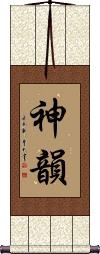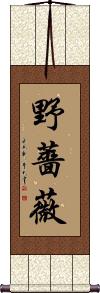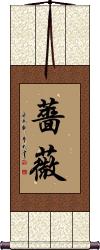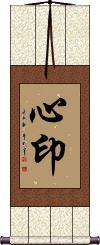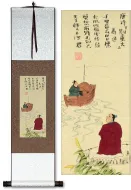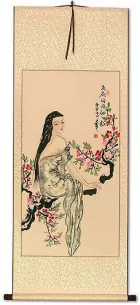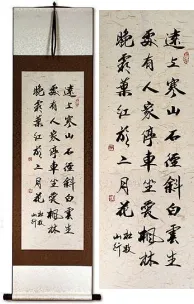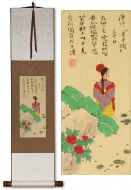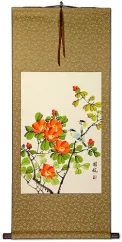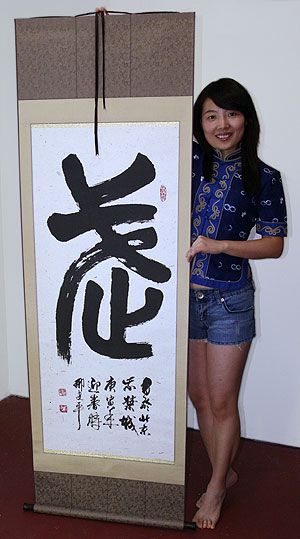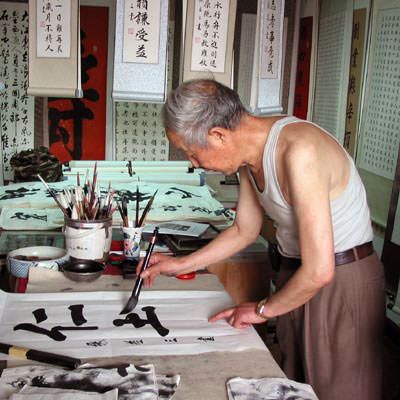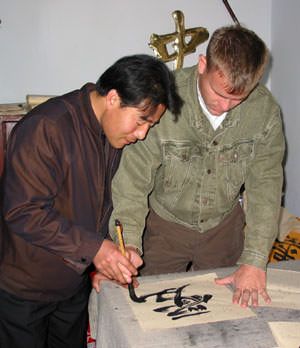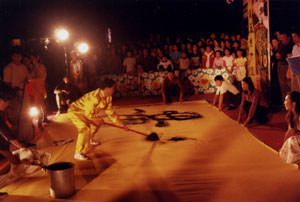Many custom options...
And formats...

Du Mu Poetry in Chinese / Japanese...
Buy a Du Mu Poetry calligraphy wall scroll here!
Personalize your custom “Du Mu Poetry” project by clicking the button next to your favorite “Du Mu Poetry” title below...
Mountain Travels Poem by Dumu
This poem was written almost 1200 years ago during the Tang dynasty.
It depicts traveling up a place known as Cold Mountain, where some hearty people have built their homes. The traveler is overwhelmed by the beauty of the turning leaves of the maple forest that surrounds him just as night overtakes the day, and darkness prevails. His heart implores him to stop, and take in all of the beauty around him.
First, before you get to the full translation, I must tell you that Chinese poetry is a lot different than what we have in the west. Chinese words simply don't rhyme in the same way that English or other western languages do. Chinese poetry depends on rhythm and a certain beat of repeated numbers of characters.
I have done my best to translate this poem keeping a certain feel of the original poet. But some of the original beauty of the poem in its original Chinese will be lost in translation.
Far away on Cold Mountain, a stone path leads upwards.
Among white clouds, people's homes reside.
Stopping my carriage I must, as to admire the maple forest at nights fall.
In awe of autumn leaves showing more red than even flowers of early spring.
Hopefully, this poem will remind you to stop, and “take it all in” as you travel through life.
The poet's name is “Du Mu” in Chinese that is: ![]()
![]() .
.
The title of the poem, “Mountain Travels” is: ![]()
![]()
You can have the title, poet's name, and even “Tang Dynasty” written as an inscription on your custom wall scroll if you like.
More about the poet:
Dumu lived from 803-852 AD and was a leading Chinese poet during the later part of the Tang dynasty.
He was born in Chang'an, a city in central China and the former capital of the ancient Chinese empire in 221-206 BC. In present-day China, his birthplace is currently known as Xi'an, the home of the Terracotta Soldiers.
He was awarded his Jinshi degree (an exam administered by the emperor's court which leads to becoming an official of the court) at the age of 25 and went on to hold many official positions over the years. However, he never achieved a high rank, apparently because of some disputes between various factions, and his family's criticism of the government. His last post in the court was his appointment to the office of Secretariat Drafter.
During his life, he wrote scores of narrative poems, as well as a commentary on the Art of War and many letters of advice to high officials.
His poems were often very realistic and often depicted everyday life. He wrote poems about everything, from drinking beer in a tavern to weepy poems about lost love.
The thing that strikes you most is the fact even after 1200 years, not much has changed about the beauty of nature, toils, and troubles of love and beer drinking.
Charm / Grace
Rose
(Name used in botany and some poems)
野薔薇 is both the technical term for rose in the science of botany. However, it also means wild rose and can be found in some forms of poetry as well.
If you are wondering, this word for rose sounds good in Chinese, not like a super-technical such as the Latin words we use for scientific terms in the west).
Rose Flower
(The flower of love)
薔薇 is the universal way to write rose (as in the flower) because it is understood in both Chinese and Japanese (same characters in either language). 薔薇 is also a common way to write about roses in Asian poetry. This can be translated as “wild rose” if you are looking for that title.
薔薇 is also how to write “rose” in old Korean Hanja (though they now use Hangul, and most Koreans of this generation will not be able to read this without a dictionary).
Appreciation of Truth by Meditation
心印 is a Buddhist concept that simply stated is “appreciation of truth by meditation.”
It's a deep subject, but my understanding is that you can find truth through meditation, and once you've found the truth, you can learn to appreciate it more through further meditation. This title is not commonly used outside of the Buddhist community (your Asian friends may or may not understand it). The literal translation would be something like “the mind seal,” I've seen this term translated this way from Japanese Buddhist poetry. But apparently, the seal that is stamped deep in your mind is the truth. You just have to meditate to find it.
Soothill defines it this way: Mental impression, intuitive certainty; the mind is the Buddha-mind in all, which can seal or assure the truth; the term indicates the intuitive method of the Chan (Zen) school, which was independent of the spoken or written word.
Reference: Soothill-Hodous Dictionary of Chinese Buddhism
See Also: Zen
Push or Knock
To weigh one's words
During the Tang Dynasty, a man named Jia Dao (born in the year 779), a well-studied scholar and poet, went to the capital to take the imperial examination.
One day as he rides a donkey through the city streets, a poem begins to form in his mind. A portion of the poem comes into his head like this:
“The bird sits on the tree branch near a pond,
A monk approaches and knocks at the gate...”
At the same time, he wondered if the word “push” would be better than “knock” in his poem.
As he rides down the street, he imagines the monk pushing or knocking. Soon he finds himself making motions of pushing and shaking a fist in a knocking motion as he debates which word to use. He is quite a sight as he makes his way down the street on his donkey with hands and fists flying about as the internal debate continues.
As he amuses people along the street, he becomes completely lost in his thoughts and does not see the mayor's procession coming in the opposite direction. Jia Bao is blocking the way for the procession to continue down the road, and the mayor's guards immediately decide to remove Jia Bao by force. Jia Bao, not realizing that he was in the way, apologizes, explains his poetic dilemma and awaits his punishment for blocking the mayor's way.
The mayor, Han Yu, a scholar and author of prose himself, finds himself intrigued by Jia Dao's poem and problem. Han Yu gets off his horse and addresses Jia Bao, stating, “I think knock is better.” The relieved Jia Bao raises his head and is invited by the mayor to join the procession, and are seen riding off together down the street, exchanging their ideas and love of poetry.
In modern Chinese, this 反復推敲 idiom is used when someone is trying to decide which word to use in their writing or when struggling to decide between two things when neither seems to have a downside.
This in-stock artwork might be what you are looking for, and ships right away...
Gallery Price: $200.00
Your Price: $88.88
Gallery Price: $160.00
Your Price: $88.77
Not the results for du mu poetry that you were looking for?
Below are some entries from our dictionary that may match your du mu poetry search...
| Characters If shown, 2nd row is Simp. Chinese |
Pronunciation Romanization |
Simple Dictionary Definition |
神韻 神韵 see styles |
shén yùn shen2 yun4 shen yün shinin しんいん |
More info & calligraphy: Charm / Graceexceptional artistry |
バラード see styles |
baraado / barado バラード |
More info & calligraphy: Ballard |
仄 see styles |
zè ze4 tse hono ほの |
to tilt; narrow; uneasy; oblique tones (in Chinese poetry) (prefix) (kana only) (See ほの白い,ほの見える) faintly; dimly; slightly; barely |
句 see styles |
jù ju4 chü ku く |
sentence; clause; phrase; classifier for phrases or lines of verse (n,n-suf) (1) section (i.e. of text); sentence; passage; paragraph; (n,n-suf) (2) {ling} phrase; (n,n-suf) (3) verse (of 5 or 7 mora in Japanese poetry; of 4, 5, or 7 characters in Chinese poetry); (n,n-suf) (4) haiku; first 17 morae of a renga, etc.; (n,n-suf) (5) maxim; saying; idiom; expression; (n,n-suf) (6) {comp} clause (e.g. in a database query language) A sentence, phrase, clause; also used for a place. |
吟 see styles |
yín yin2 yin gin ぎん |
to chant; to recite; verse; song (often used in titles of classical poems); (literary) to lament; to groan; (bound form) (in poetry) the cry of certain animals and insects; (music) rapid vibrato (technique for playing the guqin 古琴[gu3qin2]) (cf. 猱[nao2], wide vibrato) (1) recitation (of a poem); chanting; singing; (2) composition (of a poem); composed poem; (n,n-suf) (3) classical Chinese poetry form; (n,suf) (4) stress of sound in noh song; (female given name) Gin Chant, hum, mutter. |
持 see styles |
chí chi2 ch`ih chih ji じ |
to hold; to grasp; to support; to maintain; to persevere; to manage; to run (i.e. administer); to control draw (in go, poetry contest, etc.); tie; (surname) Mochitoku dhṛ; dhara. Lay hold of, grasp, hold, maintain, keep; control. |
撰 see styles |
zhuàn zhuan4 chuan sen せん |
to compose; to compile (n,n-suf) (sometimes confused with 選) (See 選・せん) anthology (of poetry, etc.); compilation; collection; selection; (surname) Erami To compose, compile. |
昆 see styles |
kūn kun1 k`un kun kon こん |
descendant; elder brother; a style of Chinese poetry (s,m) Kon |
歌 see styles |
gē ge1 ko kasumi かすみ |
song (CL:首[shou3],支[zhi1]); (bound form) to sing (1) song; (2) classical Japanese poetry (esp. tanka); (3) modern poetry; (personal name) Kasumi To sing; a song; translit. ka; cf. 迦, 羯. |
牌 see styles |
pái pai2 p`ai pai pai パイ |
signboard; plaque; plate; tablet (CL:塊|块[kuai4]); brand; trademark (CL:個|个[ge4]); mahjong tile; domino; playing card (CL:張|张[zhang1]); (bound form) fixed pattern for lyrics or set melody in classical poetry or music (used in 詞牌|词牌[ci2pai2] and 曲牌[qu3pai2]) (n,ctr) {mahj} tile (chi: pái) signboard |
聯 联 see styles |
lián lian2 lien tsurane つらね |
(bound form) to ally oneself with; to unite; to combine; to join; (bound form) (poetry) antithetical couplet (personal name) Tsurane to link |
詞 词 see styles |
cí ci2 tz`u tzu shi し |
word; statement; speech; lyrics; a form of lyric poetry, flourishing in the Song dynasty 宋朝[Song4chao2] (CL:首[shou3]) (1) words; writing; lyrics; (2) (See 填詞) ci (form of Chinese poetry); (3) (See 辞・3) independent word; (female given name) Kotoba An expression, phrase, word. |
詩 诗 see styles |
shī shi1 shih shi し |
poem; CL:首[shou3]; poetry; verse (1) poem; poetry; verse; (2) (See 漢詩) Chinese poem; (female given name) Shirabe poem |
讚 赞 see styles |
zàn zan4 tsan san さん |
variant of 贊|赞[zan4]; to praise a style of Chinese poetry; legend or inscription on a picture stotra, hymn, praise. |
転 see styles |
zhuǎn zhuan3 chuan ten てん |
Japanese variant of 轉|转 (1) {ling} change in pronunciation or meaning of a word; sound change; word with an altered pronunciation or meaning; (2) (abbreviation) (See 転句・てんく) turning or twisting part of a text (in Chinese poetry); (surname) Ten |
雑 see styles |
zá za2 tsa zou / zo ぞう |
Japanese variant of 雜|杂 miscellany (classification of Japanese poetry unrelated to the seasons or to love); (surname) Saisaki |
騷 骚 see styles |
sāo sao1 sao sō |
(bound form) to disturb; to disrupt; flirty; coquettish; abbr. for 離騷|离骚[Li2 Sao1]; (literary) literary writings; poetry; foul-smelling (variant of 臊[sao1]); (dialect) (of certain domestic animals) male Trouble, sad; poetic, learned; translit. su, s. |
一篇 see styles |
ippen いっぺん |
piece (e.g. poetry); poem; essay; book; story |
一編 see styles |
ippen いっぺん |
piece (e.g. poetry); poem; essay; book; story |
万葉 see styles |
manyou; mannyou / manyo; mannyo まんよう; まんにょう |
(1) (abbreviation) (See 万葉集) Man'yōshū (8th century anthology of Japanese poetry); (2) (archaism) thousands of leaves; (3) (archaism) thousands of years; all ages; eternity; (female given name) Mitsuyo |
三愛 三爱 see styles |
sān ài san1 ai4 san ai sanai さんあい |
(1) koto, alcohol and poetry; the three loves; (2) {Buddh} the three desires of the realms of existence; (male given name) Miyoshi three kinds of attachment |
作文 see styles |
zuò wén zuo4 wen2 tso wen sakumon さくもん |
to write an essay; composition (student essay); CL:篇[pian1] (archaism) (See 作文・1) writing (poetry); composing |
作法 see styles |
zuò fǎ zuo4 fa3 tso fa sahou(p); sakuhou / saho(p); sakuho さほう(P); さくほう |
course of action; method of doing something; practice; modus operandi (1) (さほう only) manners; etiquette; propriety; (2) manner of production (esp. of prose, poetry, etc.); way of making Karma, which results from action, i.e. the "deeds" of body or mouth; to perform ceremonies. |
俳友 see styles |
haiyuu / haiyu はいゆう |
(haiku) poetry pals |
俳諧 see styles |
haikai はいかい |
(1) haikai; collective name for haiku, haibun, haiga, senryu, etc.; (2) (abbreviation) humorous or vulgar renga poetry |
元曲 see styles |
yuán qǔ yuan2 qu3 yüan ch`ü yüan chü genkyoku げんきょく |
Yuan dynasty theater, including poetry, music and comedy yuanqu (form of Chinese classical drama); Yuan drama |
八雲 see styles |
yakumo やくも |
(1) (archaism) thick clouds; (2) (archaism) (See 和歌) classical Japanese poetry; (place-name, surname) Yagumo |
出題 出题 see styles |
chū tí chu1 ti2 ch`u t`i chu ti shutsudai しゅつだい |
to draw up the theme (for discussion) (n,vs,vt,vi) (1) setting a question (for an exam, quiz, etc.); (n,vs,vt,vi) (2) setting a theme (for composition of poetry) |
劇詩 see styles |
gekishi げきし |
dramatic poetry |
勅題 see styles |
chokudai ちょくだい |
theme of the Imperial Poetry Contest |
Click here for more du mu poetry results from our dictionary
The following table may be helpful for those studying Chinese or Japanese...
| Title | Characters | Romaji (Romanized Japanese) | Various forms of Romanized Chinese | |
| Mountain Travels Poem by Dumu | 遠上寒山石徑斜白雲生處有人家停車坐愛楓林晚霜葉紅於二月花 远上寒山石径斜白云生处有人家停车坐爱枫林晚霜叶红于二月花 | yuǎn shàng hán shān shí jìng xiá bái yún shēng chù yǒu rén jiā tíng chē zuò ài fēng lín wǎn shuàng yè hóng yú èr yuè huā yuan3 shang4 han2 shan1 shi2 jing4 xia2 bai2 yun2 sheng1 chu4 you3 ren2 jia1 ting2 che1 zuo4 ai4 feng1 lin2 wan3 shuang4 ye4 hong2 yu2 er4 yue4 hua1 yuan shang han shan shi jing xia bai yun sheng chu you ren jia ting che zuo ai feng lin wan shuang ye hong yu er yue hua | yüan shang han shan shih ching hsia pai yün sheng ch`u yu jen chia t`ing ch`e tso ai feng lin wan shuang yeh hung yü erh yüeh hua yüan shang han shan shih ching hsia pai yün sheng chu yu jen chia ting che tso ai feng lin wan shuang yeh hung yü erh yüeh hua |
|
| Charm Grace | 神韻 神韵 | shi nin / shinin | shén yùn / shen2 yun4 / shen yun / shenyun | shen yün / shenyün |
| Rose | 野薔薇 野蔷薇 | nobara | yě qiáng wēi ye3 qiang2 wei1 ye qiang wei yeqiangwei | yeh ch`iang wei yehchiangwei yeh chiang wei |
| Rose Flower | 薔薇 蔷薇 | bara / shoubi bara / shobi | qiáng wēi qiang2 wei1 qiang wei qiangwei | ch`iang wei chiangwei chiang wei |
| Appreciation of Truth by Meditation | 心印 | shin nin / shinnin | xīn yìn / xin1 yin4 / xin yin / xinyin | hsin yin / hsinyin |
| Push or Knock | 反復推敲 反复推敲 | fǎn fù tuī qiāo fan3 fu4 tui1 qiao1 fan fu tui qiao fanfutuiqiao | fan fu t`ui ch`iao fanfutuichiao fan fu tui chiao |
|
| In some entries above you will see that characters have different versions above and below a line. In these cases, the characters above the line are Traditional Chinese, while the ones below are Simplified Chinese. | ||||
Successful Chinese Character and Japanese Kanji calligraphy searches within the last few hours...

